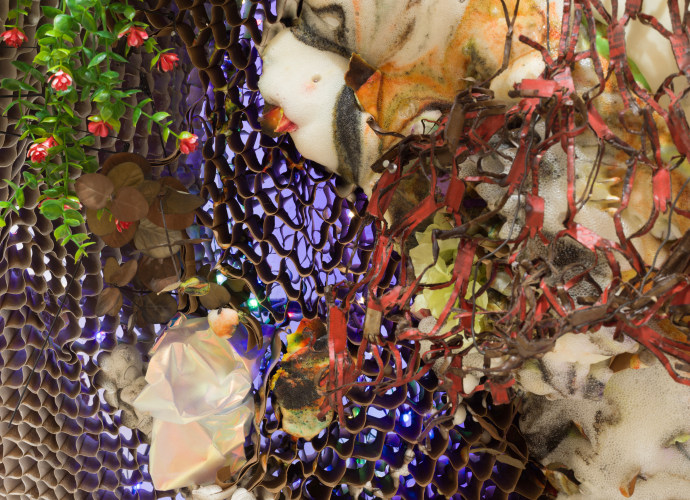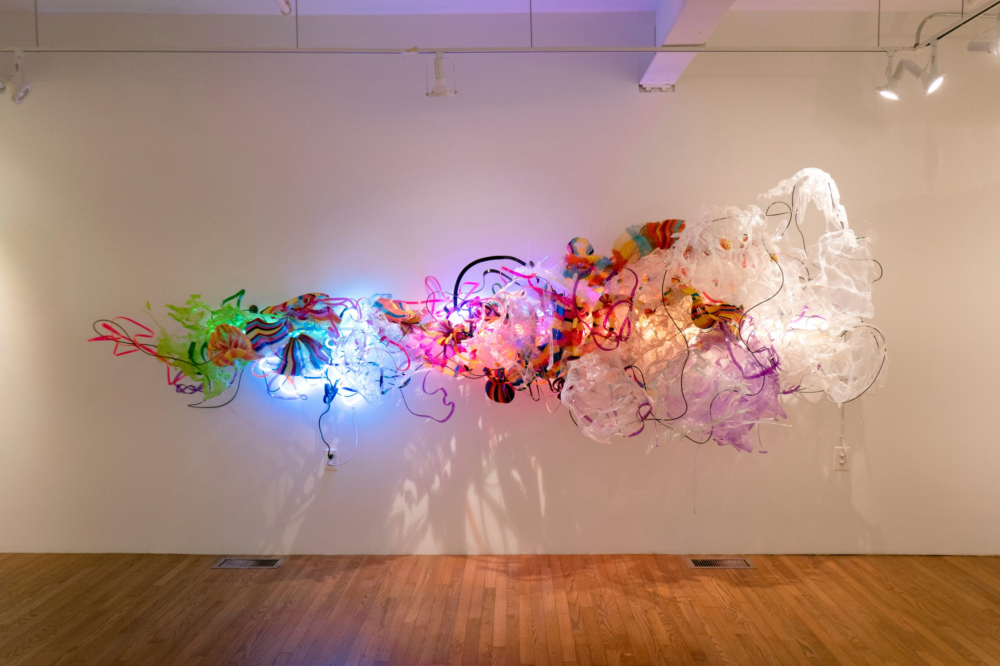
Judy Pfaff | Sculpture Magazine
By Leah Triplett Harrington
9 February 2022

Judy Pfaff, Fish Story, 2021. Steel, melted plastic, acrylic, paper lanterns, and fluorescent and neon lighting, 56 x 171 x 45 in. Photo: Courtesy the artist and Gaa Gallery
"Judy Pfaff’s current installation of wall-hung works (on view through February 18, 2022) is aptly titled “opsins,” after the tiny proteins that calibrate color within the eye’s light-sensitive retinas. Key elements in phototaxis, circadian rhythms, and other responses related to light sensitivity, opsins, which appear as curls and cords under the microscope, are found in the plant and animal worlds as well as the human. At first glance, the title seems to refer to Pfaff’s signature amalgams of twines and strips, but a second, closer look reveals a conceptual influence. Though filled with Pfaff’s typical energy, “opsins” is infused with a glowing vibrancy and color unusual for her frenetic forms. The exhibition hinges on gradations across light, color, and darkness, making it one of Pfaff’s most joyful bodies of work to date.
While color, light, and glass have long been formal and material elements in Pfaff’s work, light bulbs have only just started appearing alongside her characteristic syntheses of melted plastic, expanded foam, paper lanterns, wire, wood, and steel. Fish Story (2021) combines such familiar materials and introduces two light bulbs that bring everything together and cause the work to coalesce. On one side, a horizontal light shaft balances spindles of purple and magenta with orange strips of plastic. On the other side, a concentration of melted clear plastics glows in cast light. A loose twist of blue illumination dangles toward the floor, while cut swathes of rainbow-colored paper lanterns stretch and tangle across the wall. In between, caverns—formed as the materials pull away from each other and their supports—imbue the work with a sense of discovery. All color, texture, and mystery, Fish Story resembles a massive coral reef and recalls Deepwater (1980), one of Pfaff’s earliest installations. Installed at Holly Solomon Gallery and punctuated by bursts of materials, Deepwater was sharply angular and hectic; 41 years later, luminosity softens the edges and harmonizes chaos in Fish Story.
The bloom-like Deep-Sea Fishing (2021) continues Pfaff’s interest in life beneath the water’s surface with a precise compactness that demonstrates her fluency of formlessness. Iridescent with neon and electric light, Deep-Sea Fishing has the buoyancy of a bubble, as do several other works engaging the natural world, such as Sea Jellies, Mud Dauber, Hermit Crab, and crus•ta•cean (all 2021). These condensed sculptures create their own ecologies, yet they entangle and implicate each other, just as in the ecosystem. Light is the binder. While previous installations were intrinsically allied through material or form, the light-filled sculptures in “opsins” cast extrinsic, webby shadows that converge and recede depending on the light.
Hung tightly, with each work flowing into the next and complemented by Pfaff’s subtle, earth-toned works on paper, these individual wall pieces become symbiotic, just as we are to the plants and animals of our planet. It would be too easy, however, to read simple negative implications of the manmade in works such as Bjork (2021), with its folds of silvery exhaust pipe caught in waves of baby-blue melted plastic. Form and material are fully reconciled here, as if the artificial and biological have learned to coexist. This is emphasized in Tree Frog (2021), installed at eye level, with a face of lime-green, foregrounding swells, and stalactites of greens and blues. A central, slender drip of light green reaches down, while slight, delicate strands sway to the floor from either side, like Day-Glo vines creeping off a tree. A close look reveals a wisp dotted as if with dew drops, an intimate detail within a maximalism that plays with the dalliance between proximity and perception.
This play is the drama of “opsins,” with its webbed tension between light and dark, natural and unnatural, seen and unseen. All created during Covid-19, the works showcase a joy despite the ongoing pandemic. This ebullience only comes from acknowledging—seeing—conflict and balancing its friction. And seeing relies on small unseen particles, like opsins, that color the whole of our world." - Leah Triplett Harrington